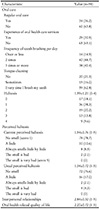1. Ministry of Health and Welfare. OECD Health statistics. Sejong: Ministry of Health and Welfare;2019.
2. Ministry of Health and Welfare. Korea Health Statistics. Korea National Health and Nutrition Examination Survey (KNHANES V-3). Sejong: Ministry of Health & Welfare;2017.
3. Noh EM, Jeon ES, Ko SY. Relationship of oral health behavior to self-efficacy among the elderly. J Korean Soc Dent Hyg. 2014; 14(2):167–176.
5. Kim HJ, Kim JH. A study of the halitosis at urban area in Dae-Gu city. J Korean Soc Dent Hyg. 2008; 8(4):387–393.
6. Jung SJ, Lee MR. A study on halitosis by oral care behavior and the oral environment. J Korea Acad Industr Coop Soc. 2016; 17(1):629–637.

7. Kim YJ, Park KM. Effects on salivation, xerostomia and halitosis in elders after oral function improvement exercises. J Korean Acad Nurs. 2012; 42(6):898–906.

8. Shin KH. Analysis of halitosis components following by sub jective cognition of halitosis and oral state. J Korean Soc Dent Hyg. 2011; 11(2):263–275.
9. Lee YO, Hong JP, Lee TY. Halitosis and related factors among rural residents. J Oral Med Pain. 2007; 32(5):157–175.
10. Eldarrat J, Alkhabuli , Malik A. The prevalence of self-reported halitosis and oral hygiene practices among libyan students and office workers. Libyan J Med. 2008; 3(4):170–176.

11. McKeown L. Social relations and breath odour. Int J Dent Hyg. 2003; 1(4):213–217.

12. Han JS, Hong JH, Choi JS. Factors associated with self-assessment of halitosis in adult. J Korea Contents Assoc. 2011; 11(12):347–356.

13. Park KA, Choi-Kwon S, Park MS. The effects of oral health care education for nursing staff on halitosis and nutrient intake of the elderly in a long-term care facility. J Korean Diet Assoc. 2011; 17(3):243–258.
14. Cho ES. Effect of self awareness of halitosis on the quality of life related to oral health in patients with chronic renal failure. J Digit Policy Manag. 2013; 11(12):607–614.

15. Lee YS, Park WS, Jung JO. The subjective recognition of halitosis in the elderly in some areas. J Korean Soc Dent Hyg. 2014; 14(5):747–755.

16. Heo HY, Shin SC, Cho JW, Park KS. A study about the relationship between worker’s mouth-odor survey and factor analysis. J Korean Acad Dent Health. 2005; 29(3):368–384.
17. Lee HS, Kim C. Effects of oral health impact profile (OHIP) on depression and quality of life among community-dwelling Korean elderly persons. J Korean Acad Community Health Nurs. 2012; 23(3):338–346.

18. Faul F, Erdfelder E, Buchner A, Lang AG. Statistical power analyses using G*power 3.1: tests for correlation and regression analyses. Behav Res Methods. 2009; 41(4):1149–1160.

19. Shin SC, Lee KS. An epidemiological study on malodor status in Korean people. J Korean Acad Dent Health. 1999; 23(4):343–359.
20. Schlein SP. Training dating couples in empathic and open communication: an experiment of a potential mental health program [unpublished dissertation]. University Park: The Pennsylvania state University;1971. English.
21. Guerney BG. Relationship enhancement: skill training programs for therapy, program prevention, and enrichment. San Francisco: Jossey-Bass;1991.
22. Hwang IO. A study on a strategy for strengthening the social adaptation of the dementia aged through [unpublished dissertation]. Busan: Busan National University;2002. Korean.
23. Slade GD, Spencer AJ. Development and evaluation of the oral health impact profile. Community Dental Health. 1994; 11(1):3–11.
24. Robinson PG, Gibson B, Khan FA, Birnbaum W. A comparison of OHIP14 and OIDP as interviewers and questionnaires. Community Dental Health. 2001; 18(3):144–149.
25. Wong MC, Lo EC, McMillan AS. Validity of a Chinese version of the oral health impact profile (OHIP). Community Dent Oral Epidemiol. 2002; 30(6):423–430.
26. Kim JO, Kim NC. Effects of 4% hypertonic saline solution mouthwash on oral health of elders in long term care facilities. J Korean Acad Nurs. 2014; 44(1):13–20.

27. Lee MR, Choi JS. Self-reported halitosis and the associated factors in adults. J Korean Soc Dent Hyg. 2013; 3(2):142–150.
28. Kim EH, Park MK, Ku IY, Moon SJ, Kim SH. The impact of oral health impact profile (OHIP-14) of subjectively reported oral status in the elderly. J Korea Acad Industr Coop Soc. 2013; 14(9):4349–4358.









